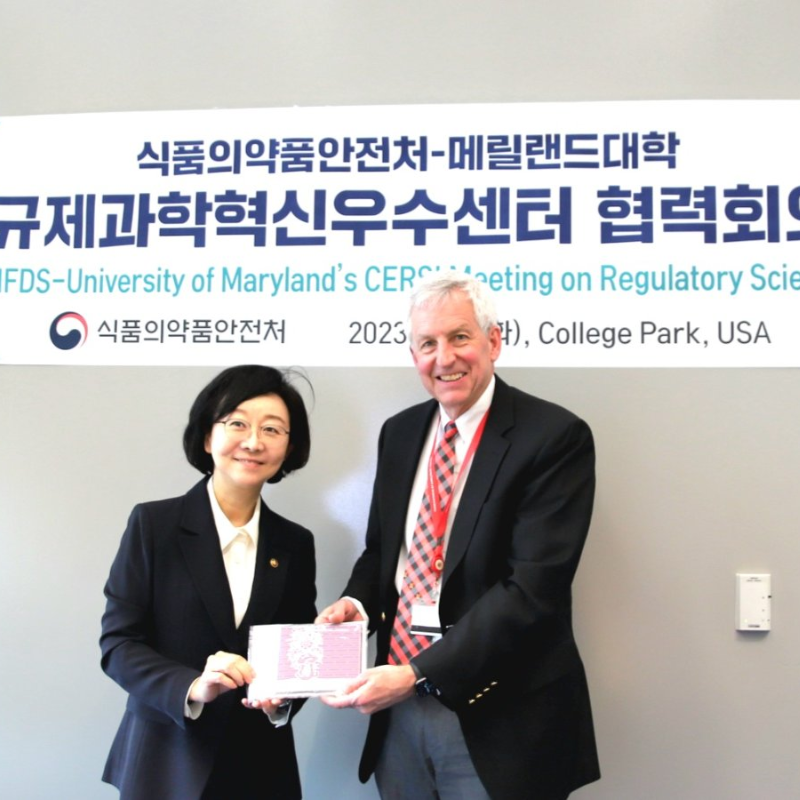News Story
"America's Got Regulatory Science Talent" Competition

Imagine returning home from the pharmacy with your recently filled prescription, taking the medication as prescribed by your health care provider, waiting a day or two and…nothing happens. Or worse, you become even more ill than before.
Unfortunately, for the millions of people around the world who are dispensed counterfeit medications each year, this situation is a grim reality, though one that may soon disappear thanks to the ingenuity of one University of Maryland graduate student.
"Counterfeit drugs are found not only in foreign countries, but in the United States as well," explained Chelsea Virgile, a graduate student in the Fischell Department of Bioengineering at the University of Maryland, College Park, as she addressed the audience at the second annual "America’s Got Regulatory Science Talent" competition hosted at the University of Maryland School of Pharmacy on Jan. 30. "According to the Center for Medicine in the Public Interest, approximately 10 percent of drugs sold around the world are counterfeits, and these drugs generate an estimated $75 billion per year in profits for counterfeiters."
Earning first place in this year’s competition, Virgile recommended replacing the Food and Drug Administration’s (FDA) CD-3 devices -- which currently test for counterfeit drugs using an ultraviolet to infrared light shined on the drug’s packaging to capture an image that can be compared to an image of an authentic sample to determine if the drug is genuine -- with advanced liquid barcoding technology. This technology, she argued, could improve current good manufacturing practices and ensure the drug’s authenticity by identifying its manufacturer, version, and intended destination directly in its liquid filler.
"Why do we only test the drug’s packaging when the technology exists to test the drug itself?" questioned Virgile. "Liquid barcoding allows manufacturers to add special, non-toxic dyes that have already been approved by the FDA into a drug’s liquid filler. Different color dyes, as well as dyes added in different quantities, could be used to provide specific information about the drug."
"Counterfeit drugs are found not only in foreign countries, but in the United States as well"
Chelsea Virgile
She added, "The need to duplicate not only the colors of the dyes, but also the quantities in which they appear, would make counterfeiting these drugs nearly impossible."
Judges Raafat Fahmy, PhD, a science advisor at the FDA; Maureen Kane, PhD, assistant professor in the Department of Pharmaceutical Sciences (PSC) at the School of Pharmacy; and Sarah Tom, PhD, assistant professor in the Department of Pharmaceutical Health Services Research (PHSR) at the School, agreed with Virgile, awarding her first place and the chance to meet with the Office of the Chief Scientist at the FDA to further discuss her proposal.
Virgile follows Curtis Gallagher, who was awarded first place in the 2013 competition for his idea to use Interactive Medication Guides (IMGs) to improve the process of reporting adverse medication events to the FDA, as the second winner of this competition. In March 2013, Gallagher met with Jesse Goodman, MD, MPH, chief scientist at the FDA, and other individuals from the regulatory agency’s MedWatch program to discuss his personal experience reporting an adverse medication event and his suggestion to improve the process.
This year, six new teams of students signed up to compete with recommendations from faculty members.
The judges awarded second place in the competition to a team of five graduate students from the School of Pharmacy’s PHSR Graduate Program for their idea to enhance the FDA's website to make information about medication safety and efficacy easier to find and more consumer-friendly. Team members included Bilal Khokhar, Melissa Ross, Xian Shen, Elisabeth Oehrlein, and Priyanka Gaitonde.
Third place was awarded to Abdulafeez Oluyadi, a second-year student pharmacist at the School of Pharmacy, for his suggestion to expand the role of pharmacogenomics in clinical studies by combining patients’ pharmacogenomic and proteomic information to create a more "holistic" approach to personalized medicine.
"Several graduate students and post-doctoral fellows already work on research projects with the FDA," says James Polli, PhD, the Shangraw/Noxell Endowed Chair in Industrial Pharmacy and Pharmaceutics at the School of Pharmacy and co-director of the University of Maryland’s Center of Excellence in Regulatory Science and Innovation (M-CERSI), which presented the competition. "This competition allows even more students from a variety of disciplines to get involved and learn about regulatory science. The quality of ideas and presentations was excellent. The student teams put a lot of effort into their proposed solutions. It was a very fun competition."
Published November 20, 2013











